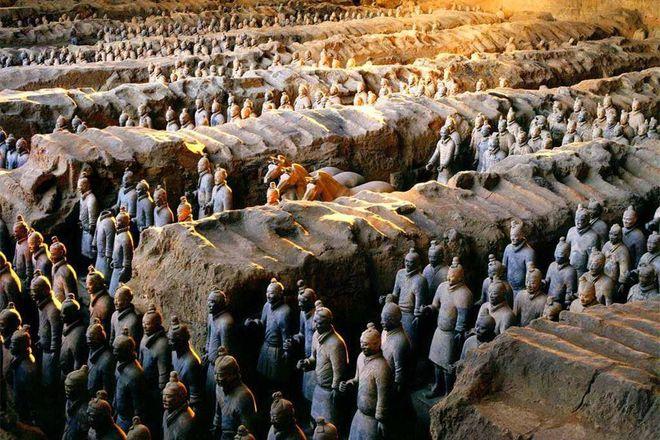
What Was Found in the Qin Shi Huang Mausoleum?
The tomb of Qin Shi Huang, the first emperor of China, is one of the most significant archaeological discoveries of all time. Located near Xi'an, Shaanxi province, China, the mausoleum complex is a vast necropolis that houses the emperor's tomb and a vast array of accompanying burial pits. Among these pits is the famed Terracotta Army, an awe-inspiring collection of life-size terracotta figures that have captivated the world's imagination.
The Terracotta Army: An Army for the Afterlife
The Terracotta Army is a vast collection of life-size terracotta sculptures depicting the armies of Qin Shi Huang. The figures were buried with the emperor between 246 and 208 BCE, intended to protect him in his afterlife. Discovered in 1974 by farmers digging a well, the Terracotta Army is considered one of the greatest archaeological finds of the 20th century and a UNESCO World Heritage Site.
The figures in the Terracotta Army are incredibly detailed and lifelike. They vary in height according to their rank, with generals being the tallest. Each figure is unique, with individual facial features, hairstyles, and armor. The army is composed of different types of soldiers, including infantry, archers, charioteers, and even cavalry, each with their unique equipment and weaponry.
The Purpose of the Terracotta Army
The sheer scale and detail of the Terracotta Army suggest that it served a highly symbolic and ritualistic purpose. The figures were not merely meant to be a realistic representation of the emperor's army but rather a spiritual embodiment of his power and authority. The army was intended to accompany and protect Qin Shi Huang in the afterlife, ensuring his continued rule in the next world.
The different types of soldiers represented in the army, their positioning within the pits, and the accompanying weapons and chariots all point to a sophisticated understanding of military strategy and tactics during the Qin dynasty. The Terracotta Army, therefore, provides invaluable insights into the military organization and warfare of ancient China.
Beyond the Terracotta Army
While the Terracotta Army is undoubtedly the most famous discovery from the Qin Shi Huang Mausoleum, the site has yielded many other treasures, including:
-
Bronze Chariots and Horses: Two bronze chariots and horses were found in a pit near the emperor's tomb, each half the life-size. The chariots are exquisitely crafted, with gold and silver ornamentation, showcasing the advanced craftsmanship of the Qin dynasty.
-
Acrobats and Entertainers: In another pit, archaeologists discovered terracotta figures of acrobats, dancers, and musicians. These figures provide a glimpse into the entertainment and cultural practices of the Qin court.
-
Rare Animals: Several pits contained the skeletons of rare and exotic animals, including a type of crane now extinct. These animals were likely tribute from different parts of the empire and illustrate the vast reach of Qin Shi Huang's power.
Ongoing Exploration and Preservation
The Qin Shi Huang Mausoleum is a vast and complex site, and excavations are ongoing. Archaeologists continue to unearth new discoveries, furthering our understanding of the Qin dynasty and Chinese history.
Preserving the site and its artifacts is a significant challenge. The terracotta figures are fragile and susceptible to damage from exposure to air and humidity. Scientists and conservationists are constantly developing new techniques to protect these priceless treasures for future generations.
Q&A
Q: Is the tomb of Qin Shi Huang open to the public?
A: While the vast majority of the Qin Shi Huang Mausoleum remains unexcavated, the Terracotta Army pits, as well as accompanying museum exhibitions, are open to the public.
Q: Why was Qin Shi Huang's tomb built on such a grand scale?
A: The scale of the mausoleum reflects Qin Shi Huang's immense power and ambition. He unified China for the first time and considered himself the first emperor of a new era. He wanted his tomb to reflect his status and achievements, even in death.
Q: What happened to the real weapons of the Terracotta Army?
A: Although the terracotta soldiers were originally equipped with real weapons, most of them were looted or decayed over time. Some bronze weapons, however, have been found in excellent condition, showcasing the advanced metallurgy of the Qin dynasty.